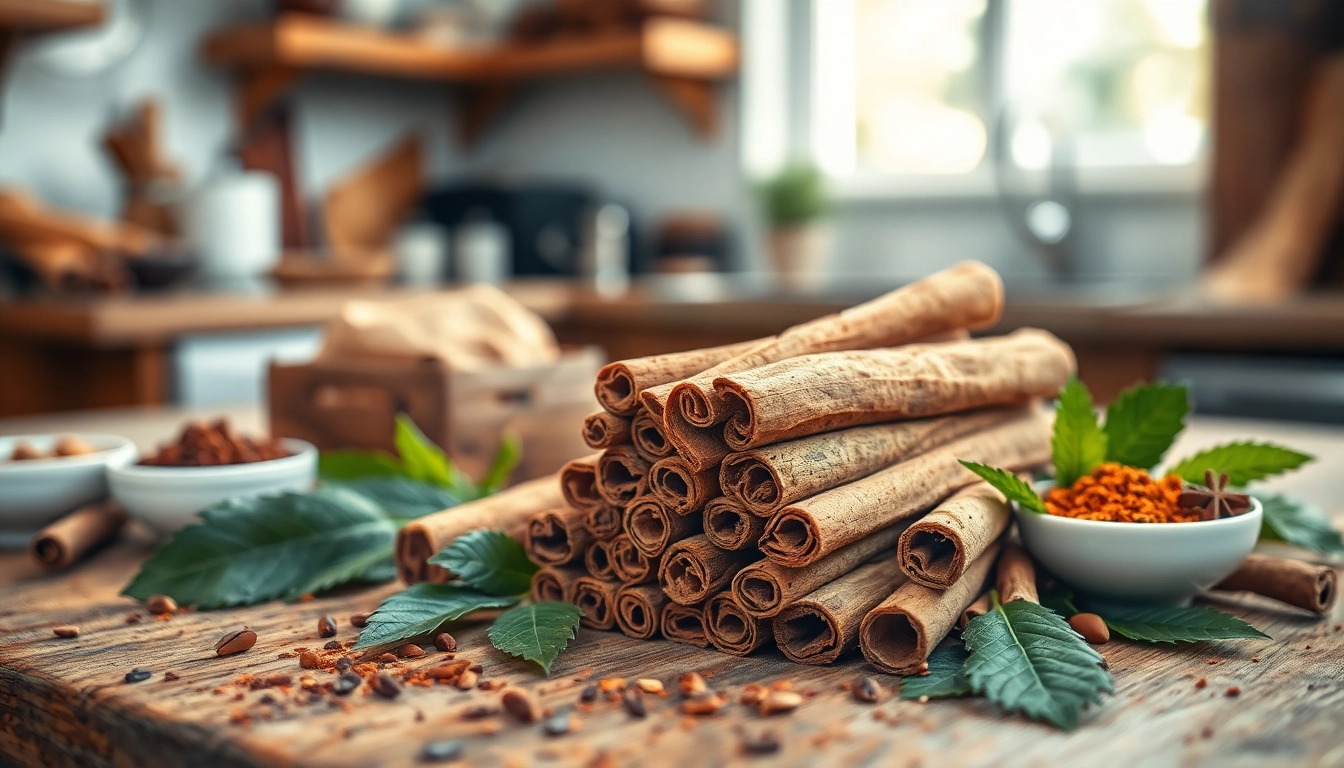Introduction to Cinnamon Bark
Cinnamon bark is not just a delightful spice associated with holiday treats but also a versatile ingredient with rich historical roots and numerous health benefits. Cinnamon Bark has been prized for centuries, woven into the fabric of various cultures through its culinary, medicinal, and aromatic properties. Understanding what cinnamon bark is, its different types, and how it can enhance our daily lives is key to appreciating this incredible spice.
What is Cinnamon Bark?
Cinnamon bark is derived from the inner bark of several tree species from the genus Cinnamomum. This spice has a warm, sweet flavor and a distinct, pleasant aroma that makes it a staple in kitchens around the world. The harvesting process involves stripping the inner bark of the tree, which is then dried and rolled into sticks or ground into powder. The two most common types of cinnamon are Ceylon, sometimes known as “true cinnamon,” and Cassia, which is more commonly found in supermarkets.
Types of Cinnamon Bark
Understanding the various types of cinnamon is critical for choosing the right one for your needs. The main types include:
- Ceylon Cinnamon: Known for its delicate and sweet flavor, it is considered the “true” cinnamon. It has a lighter color and a finer texture compared to Cassia.
- Cassia Cinnamon: More robust and spicier than Ceylon, Cassia has a stronger aroma and is the most commonly sold variety in grocery stores. It contains higher levels of coumarin, a compound that can be harmful in excessive amounts.
- Saigon Cinnamon: A variety of Cassia, it has a distinctive spicy and sweet profile, often used in baking for its intense flavor.
- Korintje Cinnamon: Originating from Indonesia, this type has a mild taste and is often used in baked goods in the United States.
Cinnamon Bark Varieties and Their Uses
Different varieties of cinnamon bark serve various culinary and medicinal purposes. Ceylon cinnamon is often preferred in gourmet cooking due to its subtlety and sweetness. In contrast, Cassia may be used for its bolder flavor in heartier dishes or processed products like cinnamon-flavored cereals and baked goods. Saigon cinnamon is particularly popular in Asian cuisines, imparting intense flavor to savory as well as sweet dishes. Understanding which type of cinnamon works best for specific recipes can enhance flavor profiles and health benefits.
The Culinary Uses of Cinnamon Bark
Cinnamon bark has a wide range of culinary uses that extend beyond the traditional holiday flavors. Its versatility makes it an excellent addition to various dishes, both sweet and savory.
Cooking with Cinnamon Bark
Cooking with cinnamon bark requires some understanding of how it interacts with other flavors. When using cinnamon sticks, they should typically be added at the beginning of a dish to allow their flavors to infuse adequately. Ground cinnamon can be sprinkled over dishes, added to batters, or mixed into sauces. When using whole cinnamon sticks, remember to remove them before serving for an optimal dining experience.
Popular Dishes Featuring Cinnamon Bark
Some popular dishes that highlight the use of cinnamon bark include:
- Chili: A pinch of cinnamon adds warmth and depth to chili, enhancing the overall flavor profile.
- Rice Pudding: Cinnamon is a classic ingredient that infuses warmth and sweetness in this creamy dessert.
- Apple Pie: Cinnamon pairs beautifully with apples, accentuating their sweetness in baked desserts.
- Curry Dishes: Cinnamon can add a surprising depth to various curry recipes, contributing to the complex flavors.
How to Store Cinnamon Bark for Freshness
To maintain the freshness and potency of cinnamon bark, store it in a cool, dark place in an airtight container. Whole cinnamon sticks will last longer than ground cinnamon, typically retaining their flavor for up to two years. Ground cinnamon should typically be used within six months to a year for the best flavor. Keep your cinnamon away from heat and moisture to prevent spoilage.
Cinnamon Bark’s Health Benefits
Cinnamon bark is more than just a flavorful spice; it offers a range of health benefits supported by scientific research. Understanding these benefits can prompt individuals to incorporate this spice more into their diets.
Nutritional Profile of Cinnamon Bark
Cinnamon bark is low in calories yet high in numerous beneficial compounds. A teaspoon of ground cinnamon contains about 6 calories and is packed with dietary fiber, antioxidants, and essential oils. It is particularly noted for its high concentration of cinnamaldehyde, a compound known for its anti-inflammatory and anti-microbial properties.
Research on Health Benefits
Numerous studies have highlighted the health benefits of cinnamon bark, including:
- Blood Sugar Regulation: Cinnamon may help improve insulin sensitivity and lower blood sugar levels, making it a useful addition for those with type 2 diabetes.
- Heart Health: Consuming cinnamon regularly may reduce levels of total cholesterol, LDL cholesterol, and triglycerides, contributing to improved heart health.
- Antioxidant Properties: The antioxidants in cinnamon can fight oxidative stress and inflammation in the body, providing a protective effect against various diseases.
Potential Side Effects and Considerations
While cinnamon boasts numerous health benefits, individuals should consume it in moderation, especially Cassia cinnamon, which contains higher levels of coumarin. Excessive intake may lead to adverse effects on liver health or blood thinning. Pregnant women and those taking blood-thinning medications should consult their healthcare provider before significantly increasing their cinnamon intake.
Incorporating Cinnamon Bark into Your Wellness Routine
Integrating cinnamon bark into your wellness routine can be both enjoyable and enriching. Here are some creative ways to make the most of this versatile spice.
Creative Ways to Use Cinnamon Bark in Recipes
Getting creative with cinnamon bark can enhance both flavor and health in your diet. Some ideas include:
- Adding to Smoothies: Blend a stick of cinnamon into fruit smoothies or protein shakes for added flavor and health benefits.
- Infusing Water: Cinnamon sticks can be added to water for a refreshing beverage that also offers health benefits.
- Dressing Up Vegetables: Roasting vegetables with cinnamon can create a unique and flavorful side dish that pairs well with savory meals.
Making Cinnamon Bark Tea and Other Beverages
Cinnamon bark tea is a delightful way to enjoy the spice’s health benefits. To make cinnamon tea, simply steep broken cinnamon sticks in hot water for 10-15 minutes. Adding honey, lemon, or even apple slices can enhance the flavor, making for a soothing beverage. Other popular drinks include cinnamon-infused coffee or lattes, offering warmth and flavor without added calories.
Essential Oils and Supplements of Cinnamon Bark
Cinnamon bark essential oil is used in aromatherapy for its warm, comforting scent and potential health benefits. It can be used in diffusers or mixed with carrier oils for topical applications, helping to promote relaxation and relieve stress. Additionally, dietary supplements containing cinnamon extract are available for those looking to harness its health benefits more significantly, but always consult a healthcare professional before beginning any new supplements.
Conclusions and Recommendations
Embracing cinnamon bark in your life can elevate both your culinary creations and your overall health. Here are some recommendations for making the most of this remarkable spice.
Best Practices for Choosing Quality Cinnamon Bark
When selecting cinnamon bark, always opt for high-quality products. Look for Ceylon cinnamon for the best flavor and health benefits. Check for freshness, and if using ground cinnamon, it should be aromatic and flavorful, not dull or stale. If possible, purchase cinnamon sticks and grind them as needed for the best flavor.
Where to Buy Cinnamon Bark
Cinnamon bark can be found in most grocery stores, health food shops, or specialty spice stores. Online retailers also offer a wide range of options, including organic varieties and unique blends. Ensure to choose reputable sellers to guarantee the quality and authenticity of the product.
Final Thoughts on Using Cinnamon Bark in Daily Life
Cinnamon bark serves as more than just a spice; it is a powerhouse of flavor, health benefits, and versatile culinary applications. By incorporating it into your meals, beverages, and wellness routines, you can enjoy not just its delightful taste but also the myriad of health advantages it offers. As with any dietary adjustment, moderation and quality are keys to making the most of this remarkable spice.



